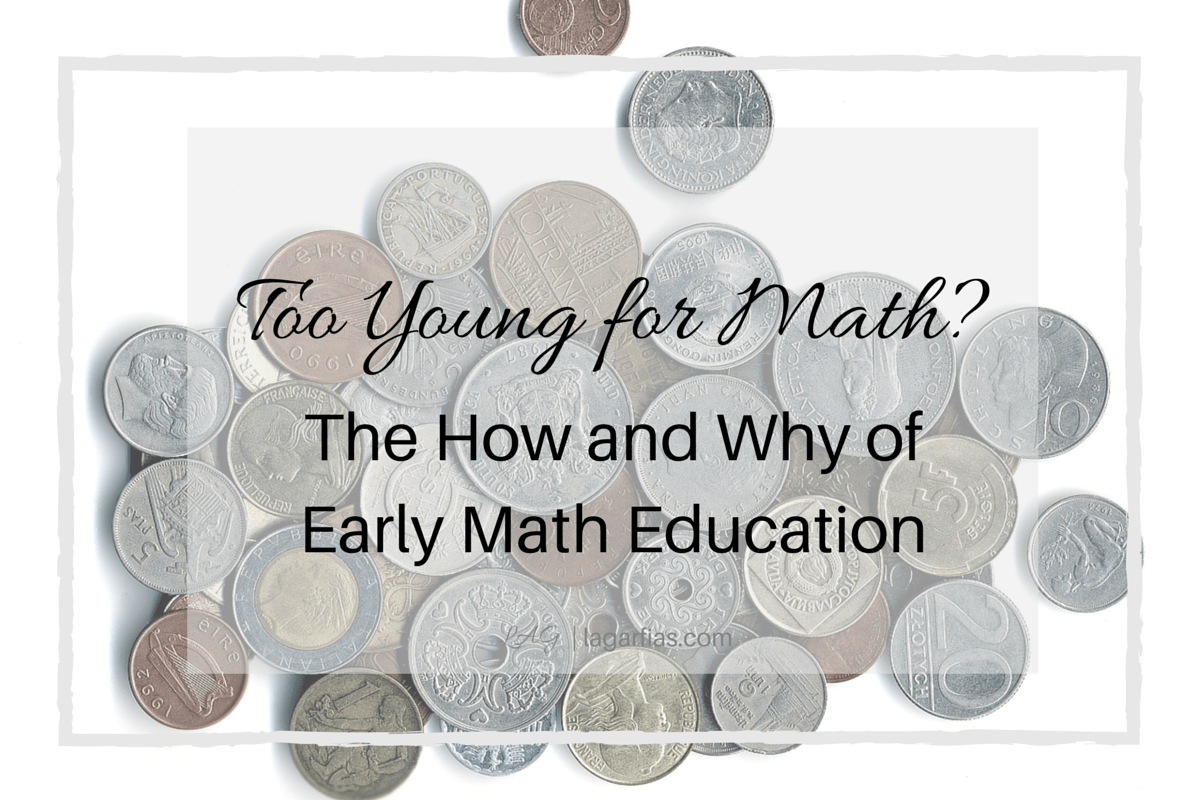
The How and Why of Early Math Education
My husband is a banker. When we were an even younger family, he managed the small branch for our community down the street and over the river from our New England parsonage. We were all so happy when the Lord gave him that job. He was excited to work with money and people – his two favorite things. I was thrilled to have him home for lunch most days. The children were ecstatic to “see Daddy’s bank.”
“Daddy’s bank” was soon on the way to and from nearly every errand I could conjure up. Daddy looked even more impressive in his bank suit and tie. The clerks all said “Yes, sir” to Daddy, obeyed him respectfully, and treated his family like royalty. Everyone was happy in Daddy’s bank, because the nice people had canisters of suckers in every color behind the counter to give out freely. And even a child received his own “banking ‘count” in which to deposit nickels and dimes and carefully add them on his ledger.
My husband is still a banker, though now he is at a much larger branch in downtown Dallas. We rarely get to visit him during business hours, but each time we do so it is still a treat. At the supper table each night, the children eagerly ask, “How was your day at work, Dad?” He will relate the goings-on of the business as it relates to the city and the people he works with, and we will all be mesmerized by his tales.
Even though my husband did not receive a college education in finance or business, it  was his family’s emphasis on the value of money and the importance of relationships that drove him to serve the Lord and his community in this vocation. Likewise, from the beginning of time ancient peoples in Egypt, Babylon, Greece, and Rome have trained their young in the principles of quantifying, describing, and handling numbers and shapes. Young children often learned these early lessons from their family members in order to explore and manage their own domain; any further mathematic instruction needed for their trade was passed from master to apprentice. This model was basically unchanged throughout the Middle Ages, until the explosion in mathematical and technological advances in the 17th and 18th centuries created the need for increased math and science education.
was his family’s emphasis on the value of money and the importance of relationships that drove him to serve the Lord and his community in this vocation. Likewise, from the beginning of time ancient peoples in Egypt, Babylon, Greece, and Rome have trained their young in the principles of quantifying, describing, and handling numbers and shapes. Young children often learned these early lessons from their family members in order to explore and manage their own domain; any further mathematic instruction needed for their trade was passed from master to apprentice. This model was basically unchanged throughout the Middle Ages, until the explosion in mathematical and technological advances in the 17th and 18th centuries created the need for increased math and science education.
Today, there is a controversy, particularly amongst home educators, regarding the education of young ones in mathematics. A few well-circulated books and papers have cited evidences that early math education can be inadvisable, and even harmful, to young children — but in actuality, these studies only prove that early institutionalization can hurt young minds and bodies. Training our child to recognize and appreciate God’s creative pattern is yet another way to teach him to “think God’s thoughts after Him,” as Johann Kepler put it.
The Science of Early Math
Numerous research papers bear this out, but I will only cite two. A recent study[1] published by Pennsylvania State University found that over the past 100 years, IQ has steadily risen across the population as early childhood mathematics instruction has increased and mathematics education was continued over a greater number of years.
The authors found that math curriculum in early grades has changed considerably over the decades to accommodate students’ growing curiosity and capabilities, turning more from rote memorization and “ciphering” to reasoning, conceptualization, and pattern recognition. These skills form the basis of higher reasoning and logic, which is tested on IQ measurements and is an indicator of future learning capability. In other words, as parents and children have acquired increasingly advanced reasoning skills, mathematics texts have been changed over time to keep up with them. This, in turn, challenges children to think critically and learn more in all subjects.
A second interesting study[2] from the Netherlands quotes investigations regarding children’s acquisition of “number sense,” and “spatial sense.” Number sense is the ability to quantify and compare amounts. Spatial sense is the ability to understand shapes, visualize them, and orient them. Spatial sense also speaks to the ability to visualize and understand space itself. Babies show the beginning of “number sense” when they realize a stack of 20 cheerios is more than a pile of 10 cheerios. Toddlers show “spatial sense” when they walk toward the kitchen for a drink; they remember the space in which the drink resides.
The studies show, amongst other things, that infants and toddlers quickly begin learning basic math principles and are eager to build upon them with wise guidance. The authors remind us, “Mathematics education for young children should intertwine with and originate from the natural experiences, the enthusiasm, and the interests of young children as they explore of the world… Performing without understanding interferes with the development of their mathematical abilities.”
Though both of these studies, and many other similar ones, were done in a classroom setting, the application to home education is profound. Parents can more readily take advantage of the natural curiosity and learning opportunities God allows during the daily interaction within the home. There is no reason to delay math learning. The key for the home educator is to lay aside the workbooks and teach young ones the reality of math principles in their own environment.
The Reality of Early Math
Young children can and should learn math by exploring and experimenting just as they learn everything else. Math education must begin with the literal world. A young child will early recognize that two cookies are more than one cookie; soon he will ask for one more cookie to get the two cookies he desires. After regularly following a similar routine for breakfast, play, lunch, nap, dinner, and sleep, he will anticipate the passage of time and understand day and night. To that he can add the pattern of the week: Sunday is church, Monday through Friday Daddy goes to work, Saturday we work in the yard, and Sunday is church again. Marking off the days of the week on the calendar and reciting them helps to cement the pattern. Then he will understand the seasons and the months. Later, he will want to tell time, and by then he is reading numbers.
It really seems to matter little what curriculum one uses for math as long as the natural progression of learning is unchecked. The young baby and toddler is allowed to explore freely with blocks, cars, small manipulatives, and shape toys; parents use plenty of math vocabulary in the early years, talking about counting, the concepts of “more” vs. “less,” and measurements; cognitive development is emphasized over written work; and when written work is first introduced (some time after the child can read and write comfortably), verbal explanation, modeling with manipulatives, or picture drawings are still more important than any worksheet.
Often a mom calls or writes me for advice on teaching math. Her child just doesn’t like it and dawdles; a son can’t remember the math facts he once knew; or the daughter suddenly is getting poor grades. Every time I ask the mother what other means besides paperwork she uses to evaluate her child’s understanding — and I usually get silence. That is a shame. Papers should hold little place in early math education (even later math education, especially if a child is struggling). Math education is about understanding and exploring God’s natural order of creation. That has little to do with paper and pencil.
Children should be learning mathematic principles as God created them, as an extension of His created order for the universe. They should be comfortable talking about His fruit as a sphere, His time as infinite, His ground as a plane, and His record of history as a line. They should speak of math when they get up in the morning, when they walk in the grocery store, when they sit to eat carrot sticks, and while they walk through the park, skip-counting all the way. The materials they use to explore math should be the flowers they pick from the yard, the soldiers from their room, their pairs of shoes, their box of raisins.
Math has many valuable lessons to teach us. We have learned many of them at the kitchen table from Daddy’s bank stories. We have learned that not adding carefully can cost one’s job. We have learned that real people make mistakes every day in their own “banking ‘counts” and are penalized. We have heard heart-breaking tales of irresponsibility resulting in the loss of homes and dreams. We have seen how helping others invest in their lives and businesses can help a bank and a community prosper. We have seen the righteous rewarded for reaching out a hand to the needy.
Through math, we see God.
First published in Home School Enrichment Sept/Oct 2010.
[1] Clancy Blair, et al., “Rising mean IQ: Cognitive Demand of Mathematics Education for Young Children, Population Exposure to Formal Schooling, and the Neurobiology of the Prefrontal Cortex,” Intelligence 33,(2005) http://language.la.psu.edu/~thorne/Intelligence2005.pdf.
[2] Fenna van Nes and Jan de Lange, “Mathematics Education and Neurosciences:Relating Spatial Structures to the Development of Spatial Sense and Number Sense,” The Montana Mathematics Enthusiast, vol.4, no.2 (2007) http://www.math.umt.edu/TMME/vol4no2/TMMEvol4no2_pp.210_229_Netherlands.pdf


My son had focusing issues when he was very young so I never did paper work or book work with him. I made everything a game. We did a thing called Drag Math. For whatever reason, he loved being dragged along the floor by his feet. Giggled with delight. So I agreed to drag him around as long as he answered addition questions and got them right. Was a great “exercise” for me too!